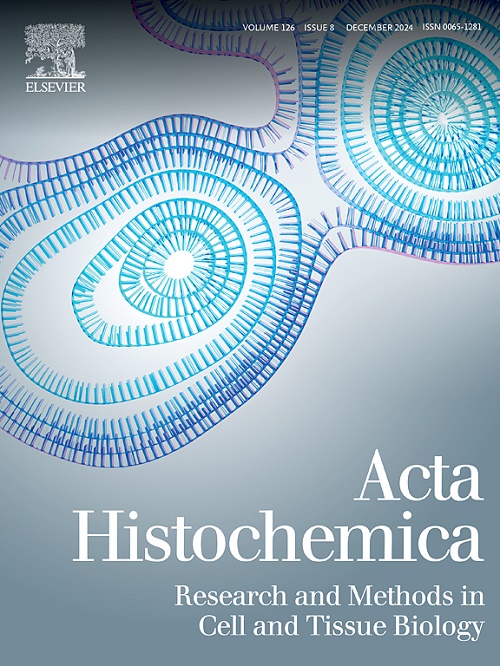EFNA1 通过磷酸化途径和上皮-间质转化促进宫颈癌的发生和转移
IF 2.4
4区 生物学
Q4 CELL BIOLOGY
引用次数: 0
摘要
宫颈癌(cervical cancer, CC)是严重威胁妇女健康的常见妇科疾病。本研究旨在通过生物信息学探索与CC预后相关的关键基因和通路,为CC的进一步治疗提供新的见解。富集分析探讨了cc相关差异表达基因(DEGs)的作用和途径。使用维恩图确定预后关键基因并进行生存分析。采用基因集富集分析(Gene Set Enrichment Analysis, GSEA)研究关键基因的潜在通路。研究了关键基因与临床特征之间的相关性。通过体外和体内免疫组织化学、流式细胞术、transwell、MTT和Western blot检测验证了关键基因的功能。结果在健康和肿瘤宫颈组织中发现2459个基因表达上调。这些deg主要富集于PI3K-AKT和MAPK通路。此外,EFNA1被认为是CC中一个关键的预后基因,与正常组织相比,其表达升高。Kaplan-Meier分析证实EFNA1水平与患者生存率呈负相关。此外,EFNA1的表达与癌症分期相关,并与抗原呈递、叶酸合成和IL-17信号传导有关。敲低EFNA1可增强细胞凋亡,减少细胞在体内和体外的迁移、侵袭和增殖,抑制EMT和MAPK通路。本研究揭示了CC进展中的关键信号通路,并确定EFNA1是一个关键的预后生物标志物,可能影响CC的治疗。本文章由计算机程序翻译,如有差异,请以英文原文为准。
EFNA1 promotes the tumorigenesis and metastasis of cervical cancer by phosphorylation pathway and epithelial-mesenchymal transition
Background
Cervical cancer (CC) is a common gynecological disease that seriously threatens women’s health. This study aims to explore key genes and pathways related to CC prognosis through bioinformatics, providing new insights for further treatment of CC.
Methods
CC patient data were analyzed from the public databases. The enrichment analyses explored the roles and pathways of CC-related differentially expressed genes (DEGs). A prognostic key gene was identified using Venn diagrams and subjected to survival analysis. Gene Set Enrichment Analysis (GSEA) was employed to investigate the potential pathways of key genes. Correlations between the key gene and clinical features were examined. The function of the key gene was validated through immunohistochemistry, flow cytometry, transwell, MTT, and Western blot assays in vitro and in vivo.
Results
Our research identified 2459 upregulated genes among DEGs between healthy and tumor cervical tissues. These DEGs were primarily enriched in the PI3K-AKT and MAPK pathways. Moreover, EFNA1 was recognized as a key prognostic gene in CC, with elevated expression compared to normal tissue. A negative correlation between EFNA1 levels and patient survival rates was corroborated by Kaplan-Meier analysis. Furthermore, EFNA1 expression correlated with the cancer stage and was linked to antigen presentation, folate synthesis, and IL-17 signaling. Knockdown of EFNA1 enhanced apoptosis and reduced migration, invasion, and proliferation in vitro and in vivo, inhibiting EMT and MAPK pathways.
Conclusion
This study revealed the key signaling pathways in CC progression and identified EFNA1 as a crucial prognostic biomarker, potentially impacting CC treatment.
求助全文
通过发布文献求助,成功后即可免费获取论文全文。
去求助
来源期刊

Acta histochemica
生物-细胞生物学
CiteScore
4.60
自引率
4.00%
发文量
107
审稿时长
23 days
期刊介绍:
Acta histochemica, a journal of structural biochemistry of cells and tissues, publishes original research articles, short communications, reviews, letters to the editor, meeting reports and abstracts of meetings. The aim of the journal is to provide a forum for the cytochemical and histochemical research community in the life sciences, including cell biology, biotechnology, neurobiology, immunobiology, pathology, pharmacology, botany, zoology and environmental and toxicological research. The journal focuses on new developments in cytochemistry and histochemistry and their applications. Manuscripts reporting on studies of living cells and tissues are particularly welcome. Understanding the complexity of cells and tissues, i.e. their biocomplexity and biodiversity, is a major goal of the journal and reports on this topic are especially encouraged. Original research articles, short communications and reviews that report on new developments in cytochemistry and histochemistry are welcomed, especially when molecular biology is combined with the use of advanced microscopical techniques including image analysis and cytometry. Letters to the editor should comment or interpret previously published articles in the journal to trigger scientific discussions. Meeting reports are considered to be very important publications in the journal because they are excellent opportunities to present state-of-the-art overviews of fields in research where the developments are fast and hard to follow. Authors of meeting reports should consult the editors before writing a report. The editorial policy of the editors and the editorial board is rapid publication. Once a manuscript is received by one of the editors, an editorial decision about acceptance, revision or rejection will be taken within a month. It is the aim of the publishers to have a manuscript published within three months after the manuscript has been accepted
 求助内容:
求助内容: 应助结果提醒方式:
应助结果提醒方式:


